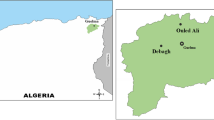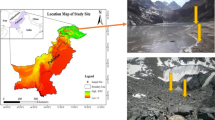Abstract
A total of 88 bacterial strains were isolated from six Andean lakes situated at altitudes ranging from 3,400 to 4,600 m above sea level: L. Aparejos (4,200 m), L. Negra (4,400 m), L. Verde (4,460 m), L. Azul (4,400 m), L. Vilama (4,600 m), and Salina Grande (3,400 m). Salinity ranged from 0.4 to 117 ppm. General diversity was determined by denaturing gradient gel electrophoresis (DGGE) analysis. From the excised DGGE bands, 182 bacterial sequences of good quality were obtained. Gammaproteobacteria and Cytophaga/Flavobacterium/Bacteroides (CFB) were the most abundant phylogenetic groups with 42% and 18% of identified bands, respectively. The isolated strains were identified by sequence analysis. Isolated bacteria were subjected to five different UV-B exposure times: 0.5, 3, 6, 12, and 24 h. Afterwards, growth of each isolate was monitored and resistance was classified according to the growth pattern. A wide interspecific variation among the 88 isolates was observed. Medium and highly resistant strains accounted for 43.2% and 28.4% of the isolates, respectively, and only 28.4% was sensitive. Resistance to solar radiation was equally distributed among the isolates from the different lakes regardless of the salinity of the lakes and pigmentation of isolates. Of the highly resistant isolates, 44.5% belonged to gammaproteobacteria, 33.3% to betaproteobacteria, 40% to alphaproteobacteria, 50% to CFB, and among gram-positive organisms, 33.3% were HGC and 44.5% were Firmicutes. Most resistant strains belonged to genera like Exiguobaceterium sp., Acinetobacter sp., Bacillus sp., Micrococcus sp., Pseudomonas sp., Sphyngomonas sp., Staphylococcus sp., and Stenotrophomonas sp. The current study provides further evidence that gammaproteobacteria are the most abundant and the most UV-B-resistant phylogenetic group in Andean lakes and that UV resistance in bacteria isolated from these environments do not depend on pigmentation and tolerance to salinity.






Similar content being viewed by others
References
Agogué H, Joux F, Obernosterer I, Lebaron P (2005) Resistance of marine bacterioneuston to solar radiation. Appl Environ Microbiol 71:5282–5289
Alonso-Saez L, Gasol JM, Lefort T, Hofe J, Sommaruga R (2006) Effect of natural sunlight on bacterial activity and differential sensitivity of natural bacterioplankton groups in northwestern Mediterranean coastal waters. Appl Environ Microbiol 72:5806–5813
Alonso C, Pernthaler J (2006) Roseobacter and SAR11 dominate microbial glucose uptake in coastal North Sea waters. Environ Microbiol 8:2022–2030
Arrieta JM, Weinbauer MG, Herndl G (2000) Interspecific variability in sensitivity to UV radiation and subsequent recovery in selected isolates of marine bacteria. Appl Environ Microbiol 66:1468–1473
Chattopadhyay MK (2002) The link between bacterial radiation resistance and cold adaptation. J Biosci 27(2):71–73
Chattopadhyay MK (2008) Cryotolerance in bacteria: interlink with adaptation to other stress factors. Trends Microbiol 16:455
Coohill T, Häder D, Mitchell D (1996) Environmental ultraviolet photobiology: introduction. Photochem Photobiol 64:401–402
Demergasso C, Casamayor EO, Chong G, Galleguillos P, Escudero L, Pedros-Alio C (2004) Distribution of prokaryotic genetic diversity in athalassohaline lakes of the Atacama Desert, Northern Chile. FEMS Microbiol Ecol 4:57–69
Demergasso C, Escudero L, Casamayor EO, Chong G, Balagué V (2008) Pedrós Novelty and spatio-temporal heterogeneity in the bacterial diversity of hypersaline Lake Tebenquiche (Salar de Atacama). Extremophiles 12(4):491–504
Dorador C (2007) Microbial communities in high altitude altiplanic wetlands in northern Chile: phylogeny, diversity and function. Ph.D. thesis, Christian-Albrechts-Universitat
Dib J, Fenandez Zenoff MV, Motok J, Ordoñez O, Farías ME (2008) Occurrence of resistance to antibiotics, UV-B and arsenic in bacteria isolated from extreme environment in high altitude Andean saline lakes (4,560 m and 4,400 m altitude). Curr Microbiol 56:510–517
Dyall-Smith M (2008) The halohandbook (v7.0). Available at http://haloarchaea.com/resources/halohandbook/index.html (May, posting date)
Ellis RJ, Morgan P, Weightman AJ, Fry JC (2003) Cultivation-dependent and -independent approaches for determining bacterial diversity in heavy-metal-contaminated soil. Appl Environ Microbiol 69:3223–3230
Farias ME Fernandez-Zennof V, Flores R, Ordoñez O, Estevez C (2008) Impact of solar radiation on bacterioplankton in Laguna Vilama, a hypersaline Andean Saline Lake (4,650 m). J Geophys Res (in press)
Felsenstein J (1985) Confidence limits on phylogenies: an approach using the bootstrap. Evolution 39:783–791
Fernández Zenoff V, Siñeriz F, Farías ME (2006) Diverse responses to UV-B radiation and repair mechanisms of bacteria isolated from high altitude aquatic environments (3, 600–4,560 m). Appl Environ Microbiol 72:7857–7864
Fernández Zenoff V (2008) Doctoral thesis, PROIMI Tucuman Argentina
Gascón J, Oubiña A, Pérez-Lezaun A, Urmeneta J (1995) Sensitivity of selected bacterial species to UV radiation. Curr Microbiol 30:177–182
George AL, Peat HJ, Buma AG (2002) Evaluation of DNA dosimeter to assess ozone-mediated variability of biologically harmful radiation in Antarctica. Photochem Photobiol 76:274–280
Häder DP, Kumar HD, Smith RC, Worrest RC (2007) Effects of solar UV radiation on aquatic ecosystems and interactions with climate change. Photochem Photobiol Sci 6:267–285
Halac S, Felip M, Camarero L, Sommaruga-Wögrath S, Psenner R, Catalan J, Sommaruga R (1997) An in situ enclosure experiment to test the solar UV-B impact on microplankton in a high altitude mountain lake: lack of effect on phytoplankton species composition and growth. J Plankton Res 11:1671–1687
Hermansson M, Jones GW, Kjelleberg S (1987) Frequency of antibiotic and heavy metal resistance, pigmentation, and plasmids in bacteria of the marine air–water interface. Appl Environ Microbiol 53:2338–2342
Jiang H, Dong H, Yu B, Liu X, Li Y, Ji S, Zhang CL (2007) Microbial response to salinity change in Lake Chaka, a hypersaline lake on Tibetan plateau. Environ Microbiol 10:2603–2621
Joux F, Jeffrey WH, Lebaron P, Mitchell DL (1999) Marine bacterial isolates display diverse responses to UV-B radiation. Appl Environ Microbiol 65(9):3820–3827
Liu Y, Yao T, Jiao N, Kang S, Zeng Y, Huang S (2006) Microbial community structure in moraine lakes and glacial meltwaters, Mount Everest. FEMS Microbiol Lett 265(1):98–105
Maki JS (2002) Neuston microbiology: life at the air–water interface. In: Bitton G (ed) The encyclopedia of environmental microbiology. Wiley, New York, NY, pp 2133–2144
Mantelli F, Scala C, Ronchi A, Gatti A, Minoia C (2003) Macrocostituenti ed elementi in traccia nelle acque dei laghi salini delle Andi de Catamarca e la Rioja (Argentina). Boll Chim Ig 54:37–44
Martin EL, Reinhardt RL, Baum LL, Becker MR, Shaffer JJ, Kokjohn TA (2000) The effects of ultraviolet radiation on the moderate halophile Halomonas elongata and the extreme halophile Halobacterium salinarum. Can J Microbiol 46:180–187
Medlin L, Elwood HJ, Stickel S, Sogin ML (1988) The characterization of enzymatically amplified eukaryotic 16S-like rRNA-coding regions. Gene 30:491–499
Moeller RE, Gilroy S, Williamson CE, Dee G, Sommaruga R (2005) Dietary acquisition of photoprotective compounds (mycosporine-like amino acids, carotenoids) and acclimation to ultraviolet radiation in a freshwater copepod. Limnol Oceanogr 50:427–439
Neale PJ, Bossard P, Huot Y, Sommaruga R (2001) Incident and in situ irradiance in Lakes Cadagno and Lucerne: a comparison of methods and models. Aquat Sci 63:250–264
Porra RJ, Thompson WA, Kriedelman PE (1989) Determination of accurate extraction and simultaneously equation for assaying chlorophyll a and b extracted with different solvents: verification of the concentration of chlorophyll standards by atomic absorption spectroscopy. Biochim Biophys Acta 975:384–394
Saitou N, Nei M (1987) The neighbor-joining method: a new method for reconstructing phylogenetic trees. Mol Biol Evol 4:406–425
Seufferheld M, Alvarez H, Farías ME (2008) Polyphosphates as microbial modulators of environmental stress minireview. Appl Environ Microbiol 74:5867–5874
Smith BT, Walker GC (1998) Mutagenesis and more: umuDC and the Escherichia coli SOS response. Genetics 148:1599–1610
Sommaruga R, Obernosterer I, Herndl GJ, Psenner R (1997) Inhibitory effect of solar radiation on thymidine and leucine incorporation by freshwater and marine bacterioplankton. Appl Environ Microbiol 63(11):4178–4184
Sommaruga R, Sattler B, Oberleiter A, Wille A, Sommaruga-Wögrath S, Psenner R, Felip M, Camarero L, Pina S, Gironés R, Catalán J (1999) An in situ enclosure experiment to test the solar UVB impact on plankton in a high-latitude mountain lake II. Effects on the microbial food web. J Plankton Res 21:859–876
Sommaruga R (2001) The role of UV radiation in the ecology of alpine lakes. J Photochem Photobiol 62:35–42
Sommaruga R, Augustin G (2006) Seasonality in UV transparency of an alpine lake is associated to changes in phytoplankton biomass. Aquat Sci 68:129–141
Tamura K, Nei M, Kumar S (2004) Prospects for inferring very large phylogenies by using the neighbor-joining method. Proc Natl Acad Sci USA 101:11030–11035
Tamura K, Dudley J, Nei M, Kumar S (2007) MEGA4: Molecular Evolutionary Genetics Analysis (MEGA) software version 4.0. Mol Biol Evol 24:1596–1599
Tartarotti B, Sommaruga R (2006) Seasonal dynamics of photoprotective mycosporine-like amino acids in phytoplankton and zooplankton from a high mountain lake. Limnol Oceanogr 51:1530–1541
Thompson JD, Higgins Desmond G, Gibson Toby J (1994) CLUSTAL W: improving the sensitivity of progressive multiple sequence alignment through sequence weighting, position-specific gap penalties and weight matrix choice. Nucleic Acids Res 22(22):4673–4680
Warnecke F, Sommaruga R, Sekar R, Hofer J, Pernthaler J (2005) Abundances, identity, and growth state of actinobacteria in mountain lakes of different UV transparency. Appl Environ Microbiol 71:5551–5559
Winter C, Moeseneder MM, Herndl GJ (2001) Impact of UV radiation on bacterioplankton community composition. Appl Environ Microbiol 67:665–672
Williamson Craig E, Role W (1995) Does UV-B radiation play in freshwater ecosystems? Limnol Oceanogr 40:386–392
Wu L-C, Chow K-C, Mark K-K (1983) The role of pigments in Halobacterium cutirubrum against UV radiation. Microbios Lett 24:85–90
Fernández Zenoff V, Heredia J, Ferrero MA, Siñeriz F, Farías ME (2006) Isolation of UV resistant bacteria from high altitude Andean wetland bacterial community. Curr Microbiol 52:359–362
Zhang G, Ma X, Niu F, Dong M, Feng H, An L, Cheng G (2007) Diversity and distribution of alkaliphilic psychrotolerant bacteria in the Qinghai–Tibet Plateau permafrost region. Extremophiles 11(3):415–424
Zhang G, Niu F, Ma X, Liu W, Dong M, Feng H, An L, Cheng G (2007) Phylogenetic diversity of bacteria isolates from the Qinghai–Tibet Plateau permafrost region. Can J Microbiol 53(8):1000–1010
Acknowledgments
This work was supported by PICT 2006-1707-Agencia Nacional de Promoción Científica y Tecnológica. Omar Ordoñez, Regina Flores, and Julian Dib are recipients of a CONICET fellowship.
Author information
Authors and Affiliations
Corresponding author
Rights and permissions
About this article
Cite this article
Ordoñez, O.F., Flores, M.R., Dib, J.R. et al. Extremophile Culture Collection from Andean Lakes: Extreme Pristine Environments that Host a Wide Diversity of Microorganisms with Tolerance to UV Radiation. Microb Ecol 58, 461–473 (2009). https://doi.org/10.1007/s00248-009-9527-7
Received:
Accepted:
Published:
Issue Date:
DOI: https://doi.org/10.1007/s00248-009-9527-7




